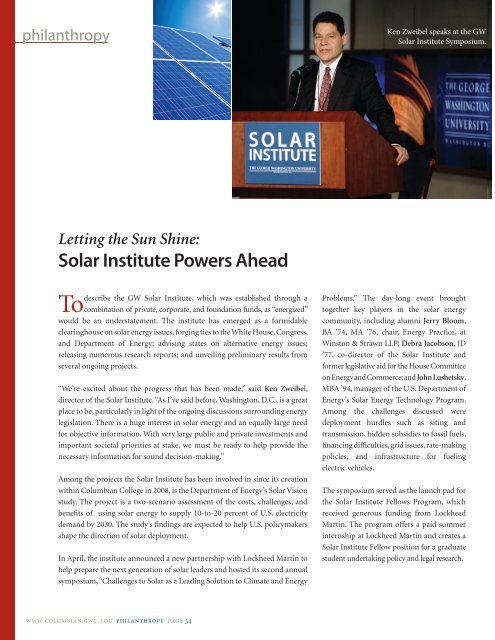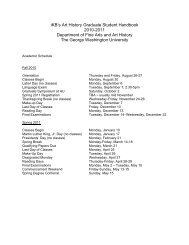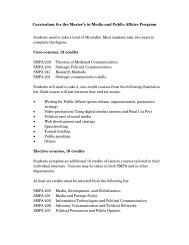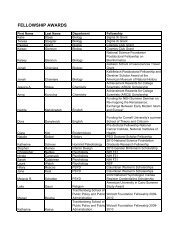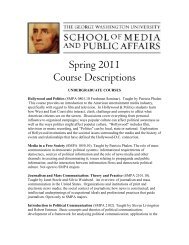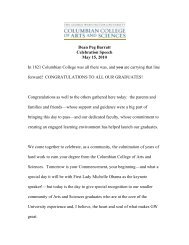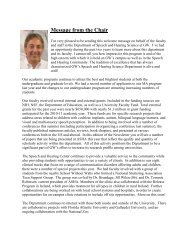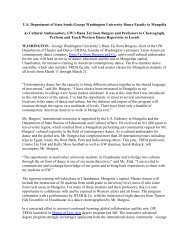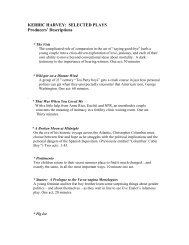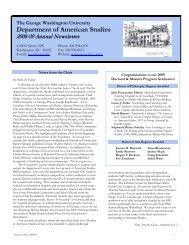Autism Forensic Science Immigration Trends Teaching Recipe for ...
Autism Forensic Science Immigration Trends Teaching Recipe for ...
Autism Forensic Science Immigration Trends Teaching Recipe for ...
You also want an ePaper? Increase the reach of your titles
YUMPU automatically turns print PDFs into web optimized ePapers that Google loves.
philanthropy<br />
Letting the Sun Shine:<br />
solar institute powers Ahead<br />
describe the GW Solar Institute, which was established through a<br />
To combination of private, corporate, and foundation funds, as “energized”<br />
would be an understatement. The institute has emerged as a <strong>for</strong>midable<br />
clearinghouse on solar energy issues, <strong>for</strong>ging ties to the White House, Congress,<br />
and Department of Energy; advising states on alternative energy issues;<br />
releasing numerous research reports; and unveiling preliminary results from<br />
several ongoing projects.<br />
“We’re excited about the progress that has been made,” said ken Zweibel,<br />
director of the Solar Institute. “As I’ve said be<strong>for</strong>e, Washington, D.C., is a great<br />
place to be, particularly in light of the ongoing discussions surrounding energy<br />
legislation. There is a huge interest in solar energy and an equally large need<br />
<strong>for</strong> objective in<strong>for</strong>mation. With very large public and private investments and<br />
important societal priorities at stake, we must be ready to help provide the<br />
necessary in<strong>for</strong>mation <strong>for</strong> sound decision-making.”<br />
Among the projects the Solar Institute has been involved in since its creation<br />
within Columbian College in 2008, is the Department of Energy’s Solar Vision<br />
study. The project is a two-scenario assessment of the costs, challenges, and<br />
benefits of using solar energy to supply 10-to-20 percent of U.S. electricity<br />
demand by 2030. The study’s findings are expected to help U.S. policymakers<br />
shape the direction of solar deployment.<br />
In April, the institute announced a new partnership with lockheed Martin to<br />
help prepare the next generation of solar leaders and hosted its second annual<br />
symposium, “Challenges to Solar as a leading Solution to Climate and Energy<br />
www.columbian.gwu.edu philanthropy page 34<br />
Ken Zweibel speaks at the GW<br />
Solar Institute Symposium.<br />
Problems.” The day-long event brought<br />
together key players in the solar energy<br />
community, including alumni Jerry Bloom,<br />
BA ’74, MA ’76, chair, Energy Practice, at<br />
Winston & Strawn llP; debra Jacobson, JD<br />
’77, co-director of the Solar Institute and<br />
<strong>for</strong>mer legislative aid <strong>for</strong> the House Committee<br />
on Energy and Commerce; and John Lushetsky,<br />
MBA ’94, manager of the U.S. Department of<br />
Energy’s Solar Energy Technology Program.<br />
Among the challenges discussed were<br />
deployment hurdles such as siting and<br />
transmission, hidden subsidies to fossil fuels,<br />
financing difficulties, grid issues, rate-making<br />
policies, and infrastructure <strong>for</strong> fueling<br />
electric vehicles.<br />
The symposium served as the launch pad <strong>for</strong><br />
the Solar Institute Fellows Program, which<br />
received generous funding from lockheed<br />
Martin. The program offers a paid summer<br />
internship at lockheed Martin and creates a<br />
Solar Institute Fellow position <strong>for</strong> a graduate<br />
student undertaking policy and legal research.


